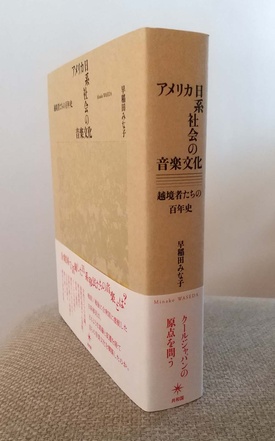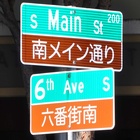
What is Nikkei? There are many themes that can make you think about this, such as politics, economics, sports, and food culture, but what will become clear if you focus on music? The answer to such an intriguing question emerges from the book "Music Culture of American Nikkei Society: A Hundred Years of Border Crossers" (Kyokubun) recently published by Professor Waseda Minako of the National College of Music, who has been researching this field for many years, a field that is rarely seen in the study of Nikkei culture.
The author focuses on the Japanese community in Los Angeles County, California, which has the largest Japanese population in North America among all Japanese communities in the United States. This book examines the music that was familiar to the people of this community, which was formed in modern times by immigrants from Japan, from two major perspectives: "historical" and "socio-cultural."
Music does not necessarily remain in a physical form (record) like literature. To research it, one must go to the places where the music can be heard, interview the people who play it, listen to various sound sources, and carry out a variety of other tasks.
So what happened to the author?
"During our fieldwork, we visited Bon Odori festivals, concerts, and other places where music was being played, and were able to learn specifically about what kind of music was being played and how people responded to it. Records, CDs, and other audio sources, as well as DVDs and videos on YouTube, also became valuable resources," explains Professor Waseda. "We also analyzed the characteristics of new Bon Odori songs created by Japanese-Americans by transcribing them into sheet music."
Through this careful research, the author explores the relationship between Japanese people and music, beginning with the beginning of immigration (immigration) from Japan at the end of the 19th century. Once immigrants established a life in a foreign country, it was natural that they would seek leisure and cultural activities rather than just work, and one of the indispensable things at that time was song and music. Of course, this was the Japanese music that they were familiar with.
This type of music was initially brought to Japan by traveling performers, but gradually professional entertainers and musicians came from Japan and spread it throughout the Japanese community, and eventually professional teachers began to appear within the Japanese community as well.
This is probably not so different from the system of entertainment and music trends in Japan, but what's interesting is that, for example, the spread of records led to an "Ondo boom" from Japan, giving birth to "Rafu Ondo" and "Amerika Ondo." This shows how extremely "Japanese" the Japanese community is, even in America.
However, as time passed and the war began, the situation changed. Japanese Americans developed cultural activities in the special space of the internment camps, which were reserved for them only. This also seemed to be quite different between the first and second generation. Ironically, because the first generation lived together in the camps and they had more free time, it became easier for them to learn Japanese music from instructors and they became more familiar with it.
On the other hand, some second-generation Americans who were born and raised in American culture became involved in musical activities, such as forming jazz bands in the camps. The book lists the jazz bands in the camps, with 18 bands in 11 locations.
If the Japanese music familiar to Japanese Americans in America is the musical culture of Japanese American society, then it is also clear that the Western music that Japanese Americans are familiar with and disseminate is also a part of Japanese American society.
Unique culture seen in group drumming
Among these various forms of "Japanese music culture," taiko has developed uniquely, mainly among the third generation after the war. Kumi-daiko, a group of large and small drums played together, often appears at Japan-related festivals and events in the United States. I have seen them not only on the West Coast but also in Idaho and Florida, and according to this book, as of 2018, there are approximately 230 taiko groups in North America.
While this kumi-daiko certainly has its roots in Japan, it has developed in a way that has not been seen in Japan, and now seems to be spreading beyond the Japanese framework to Asian countries. The author gives the following reasons for the spread of kumi-daiko:
"You don't need to speak Japanese. It involves physical performance and is appealing to young people. It also has the effect of overturning the image of Japanese people as model minorities, which are stereotyped as being non-aggressive and quiet. Kumidaiko is new in Japan, so Japanese people don't feel inferior to Japanese people. There is no iemoto system or licensing system, and there are no absolute forms or rules, so Japanese people can incorporate what they like about Japanese taiko and freely blend in elements of other cultures to create their own unique expressions."
The author, who is also well-versed in black music, observes that these characteristics mean that "just as jazz is recognized as African-American music and at the same time has spread worldwide as a musical genre that transcends race, kumi daiko is recognized as a part of Japanese culture or Japanese-American culture and at the same time can be said to have spread throughout the world as a form of expression that transcends ethnicity."
Within Japanese music culture, "folk protest songs" are interesting in terms of their fusion with Western music.
Inspired by the civil rights movement of the 1960s, a cultural movement to establish identity arose among Asian American youth. In terms of music, this book introduces "A Grain of Sand" and "Yokohama, California" as groups that emphasize social and political messages. They have songs that express something that is unique to Japanese and Asian Americans.
In addition, this book examines the music culture of Japanese Americans in America from various angles, such as the iemoto system, the Japanese language, and conflicts and cooperation between old and new immigrants. The book makes one keenly aware of the breadth of the theme of "Japanese American society and music," but if one changes one's perspective, it also makes one realize how diverse the concept of "Japanese American" is.
Author profile: Minako Waseda
Born in Tokyo in 1966, and raised in Kanagawa Prefecture. Completed his PhD in ethnomusicology at the University of California, Santa Barbara Graduate School. Currently a professor at Kunitachi College of Music. Specializes in ethnomusicology and Japanese American music culture.
© 2022 Ryusuke Kawai






